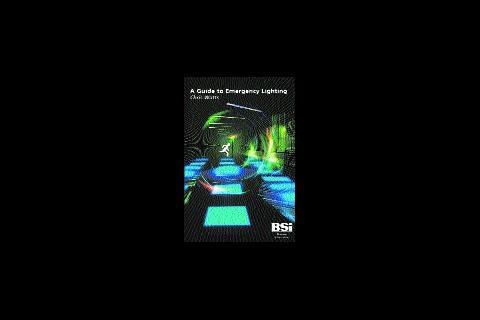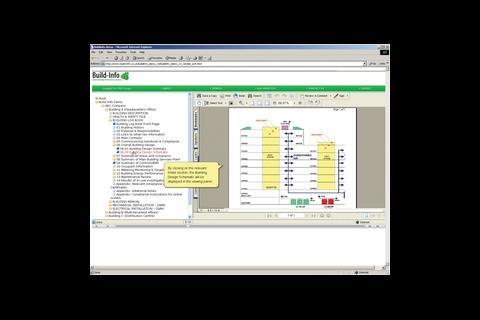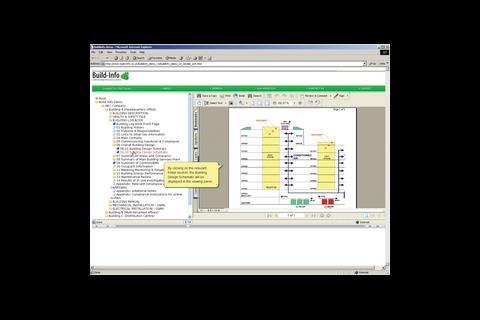Internet-based solutions such as this recently released software provide a more practical way to pass on instructions to building users, says Phil Jones
Let’s face it, designing and running buildings in the 21st century is only going to get harder. We need solutions that help busy designers meet legislation and help the facilities manager make the best of their building, particularly in controlling rising energy costs. There’s no doubt that better information leads to better management of buildings and building log books are at the heart of this.
The 21st century way to achieve this is using an online database, making building information accessible, easy to use and simple to update. The new web-based system from BUILD-INFO provides this approach to all building information, integrating log books with full online operation and maintenance manuals and health and safety files.
Sorting out poor information and communication between the disparate elements of the professional industry, FMs and building owners would do a lot to tackle carbon emissions. We need to get back to basics and provide real instructions for buildings that are accessible and understandable. Part L2A (new buildings) requires the design/construction team to provide a building log book at handover. Even more importantly, most FMs are not aware that log books are also a requirement of L2B when works are done in existing buildings. Although many design teams, FMs and building control officers are still relatively unaware of the requirements, the most switched-on are turning to online solutions.
Why? Well, online solutions make it easier to develop building O&Ms and log books. They can even be used interactively during the design process as a means of keeping track on the design. While it’s often seen as just another burden by the design team, it’s their opportunity to get across their design intent by means of instructions as to how the building is meant to be used.
Contractors are now using online solutions on-site to input as-built information directly, making the final client version more accurate and saving costs in inputting. FMs find online solutions more accessible – from anywhere in the building through to international access for large corporates.
User-friendly systems
Online database solutions such as the BUILD-INFO system are easily updatable and searchable, whereas PDF-based systems are difficult to update and changes to the building could mean extensive revision and re-issue of the documents. Overall, the BUILD-INFO solution provides a real tool that FMs can use to manage the building day to day and give improved energy performance.
The system is already being used successfully on a number of new and existing multi-building sites. Clients can use it to develop their own log book or they can train contractors to input during construction. Alternatively, BUILD-INFO can provide a full turnkey service to gather and input the information to give clients a full online set of building documentation.
Its your choice: do you want to produce 50 volumes of paper that may never be used, or an online solution that gives FMs useful instructions they can use to drive the building correctly?
The Build-info website www.build-info.co.uk has a short demonstration of the system and screen shots of the software in action. BUILD-INFO also allows potential clients to experiment with a full demo - you just need to obtain a password from Debbie Kelly on 0845 603 7208 or via debbie.kelly@build-info.co.uk.
CIBSE low carbon guide
CIBSE has published a new Technical Memorandum (TM38) on renewable and low carbon energy technologies that can be integrated into buildings or developments.
Aimed at planning authorities and developers seeking to meet local planning requirements, TM38 will also be useful to clients, architects and designers who are considering low carbon solutions for their buildings. Several academics have been consulted during the development of its content, and it has a useful secondary role as a teaching/training material.
Identifying the most appropriate low or zero carbon energy solutions for buildings and/or developments based on users’ requirements, it provides invaluable advice to be used at the early stages of a project.
A simple-to-use software tool has been developed to complement the guide, allowing users to enter basic information on the proposed building/development, and to give a relative importance to various factors such as cost-effectiveness and carbon-saving potential.
TM38 has been produced by BRE in conjunction with CIBSE and was co-funded by BRE Trust and DTI. The guidance will complement policy initiatives such as the 10% target of electricity generated by renewables by 2010, Part L2A Building Regulations, and the requirements of Planning Policy Statement 22 (PPS22).
n TM38 Renewable Energy Sources for Buildings costs £24 (plus p&p) for CIBSE members and £48 (plus p&p) for non-members and can be ordered at www.cibse.org/publications.
Energy standard updated
ASHRAE has updated its standard on energy conservation in existing buildings, designed to help owners maximise efficiency by improving operation, maintenance and energy monitoring.
ANSI/ASHRAE/IESNA Standard 100-2006, Energy Conservation in Existing Buildings, was updated to bring it in line with other ASHRAE guidance, specifically ANSI/ASHRAE/ IESNA Standard 90.1-2004, Energy Standard for Buildings Except Low-Rise Residential Buildings, and the ASHRAE handbook, HVAC Applications.
Other changes incorporated in Standard 100-2006 include updated requirements for compliance that allow for newer technology, such as more efficient lighting, that has been made available since the last update, and a revised bibliography to reflect current documents and new publications.
To order a copy of the Standard, visit the ASHRAE.org bookstore at www.ashrae.org
Emergency lighting
The British Standards Institution has released A Guide to Emergency Lighting to help those involved in the design, installation and manufacturing of emergency lighting systems.
Planned new legislation will place considerable responsibility on anyone working with fire safety risk assessments. Users of emergency lighting systems and their supporting engineers will need appropriate knowledge of the legislation, relevant standards and product practices to ensure that their legal obligations are correctly implemented. They will also have to complete documentation to demonstrate their systems comply with new requirements.
The BSI guide is written to help designers, installation and maintenance engineers, purchasers and end-users provide appropriate emergency lighting systems that comply with this new legislation.
The guide includes an overview of the standard, a look at emergency lighting, centrally powered supply systems, automatic test systems for emergency lighting, the Regulatory Reform (Fire Safety) Order, system design, system selection and photometry for emergency lighting.
A Guide to Emergency Lighting is priced £45. For more information visit www.bsi-global.com/BIP2081
Sound advice from cms
CMS Acoustic Solutions has launched The Sound Guide, a specifier's guide to acoustics.
The application-led directory provides detailed and clearly referenced information on more than 200 acoustic and anti-vibration products. It contains key technical data, physical information and acoustic performance figures for the full CMS Acoustics product portfolio, including impact and airborne sound solutions for both new build and refurbishment.
More information can be found at www.cmcacoustics.co.uk
Source
Building Sustainable Design
























No comments yet